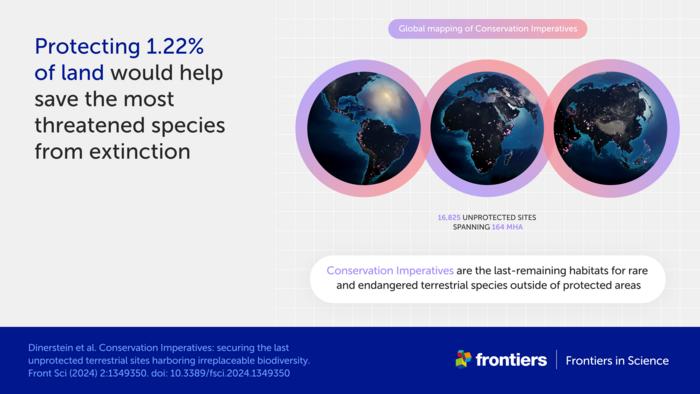In a groundbreaking new article, a coalition of conservationists and researchers have shown how we can protect Earth’s remaining biodiversity by conserving just a tiny percentage of the planet’s surface. This affordable, achievable plan would make it possible for us to preserve the most threatened species from extinction, safeguarding Earth’s wildlife for the future.

Credit: Dinerstein et al/Frontiers
In a groundbreaking new article, a coalition of conservationists and researchers have shown how we can protect Earth’s remaining biodiversity by conserving just a tiny percentage of the planet’s surface. This affordable, achievable plan would make it possible for us to preserve the most threatened species from extinction, safeguarding Earth’s wildlife for the future.
“Most species on Earth are rare, meaning that species either have very narrow ranges or they occur at very low densities or both,” said Dr Eric Dinerstein of the NGO Resolve, lead author of the article in Frontiers in Science. “And rarity is very concentrated. In our study, zooming in on this rarity, we found that we need only about 1.2% of the Earth’s surface to head off the sixth great extinction of life on Earth.”
Prioritizing the planet
To meet ambitious conservation goals, an additional 1.2 million square kilometers of land were protected between 2018 and 2023. But do these new conservation areas effectively protect critical biodiversity? Dinerstein and his colleagues estimated that the 2018-2023 expansion only covered 0.11 million square kilometers with range-limited and threatened species. Planning protected areas is crucial, ensuring that we target our efforts and resources as effectively as possible.
The scientists started by mapping the entire world, using six layers of global biodiversity data. By combining these layers of data with maps of existing protected areas and a fractional land cover analysis, using satellite images to identify the remaining habitat available to rare and threatened species, the scientists were able to identify the most critical, currently unprotected areas of biodiversity. They called these Conservation Imperatives: a global blueprint to help countries and regions plan conservation at a more local level.
These 16,825 sites, covering approximately 164 Mha, could prevent all predicted extinctions if they were adequately protected. Just protecting the sites found in the tropics could stave off most predicted extinctions. 38% of Conservation Imperatives are also very close to already-protected areas, which could make it easier to absorb them into protected areas or to find other ways of conserving them.
“These sites are home to over 4,700 threatened species in some of the world’s most biodiverse yet threatened ecosystems,” said Andy Lee of Resolve, a coauthor. “These include not only mammals and birds that rely on large intact habitats, like the tamaraw in the Philippines and the Celebes crested macaque in Sulawesi Indonesia, but also range-restricted amphibians and rare plant species.”
The cost of conservation
To calculate the price of this protection, the scientists modeled a cost estimate using data from hundreds of land protection projects over 14 years, and accounting for the type and amount of land acquired as well as country-specific economic factors. These numbers are approximate because a variety of land purchase or long-term lease options, each with different costs, might work well for protecting Conservation Imperatives. Stakeholders worldwide, including indigenous peoples, communities with jurisdiction over Conservation Imperative sites, and other members of civil society, will need to decide which options work best for them.
“Our analysis estimated that protecting the Conservation Imperatives in the tropics would cost approximately $34 billion per year over the next five years,” said Lee. “This represents less than 0.2% of the United States’ GDP, less than 9% of the annual subsidies benefiting the global fossil fuel industry, and a fraction of the revenue generated from the mining and agroforestry industries each year.”
Preserving wildlife is also key to halting and reversing the climate crisis. Preserving biodiversity means protecting the Earth’s forest cover, which acts as a carbon sink: by conserving carbon-rich, wildlife-rich forested regions, we protect both threatened species and humans. While securing Conservation Imperatives is only part of the work — for example, just purchasing land won’t prevent poaching — it’s the first critical step we need to take.
“What will we bequeath to future generations? A healthy, vibrant Earth is critical for us to pass on,” said Dinerstein. “So we’ve got to get going. We’ve got to head off the extinction crisis. Conservation Imperatives drive us to do that.”
Journal
Frontiers in Science
Method of Research
Observational study
Subject of Research
Not applicable
Article Title
Conservation Imperatives: securing the last unprotected terrestrial sites harboring irreplaceable biodiversity
Article Publication Date
25-Jun-2024
COI Statement
Authors AR and AZ are employed by the company Planet Labs PBC. The company was not involved in the study design, collection, analysis, interpretation of data, the writing of this article, or the decision to submit it for publication. This study received funding from the non‐profit organization One Earth ( which KB and SH are employed by. KB was responsible for manuscript writing and reviewing, study conceptualization, funding acquisition, supervision, and validation. SH was responsible for manuscript writing and reviewing, and funding acquisition. The remaining authors declare that the research was conducted in the absence of any commercial or financial relationships that could be construed as a potential conflict of interest. The handling editor HP declared a past collaboration with the author KB. The reviewer JK declared a shared research project Global Renewables Watch with the author AZ to the handling editor, and declared a collaboration with the author KB which started after peer review of the present manuscript. The author BL declared that they were an editorial board member of Frontiers, at the time of submission. This had no impact on the peer review process and the final decision, or those of the publisher, the editors and the reviewers. Any product
that may be evaluated in this article, or claim that may be made by its manufacturer, is not guaranteed or endorsed by the publisher.



